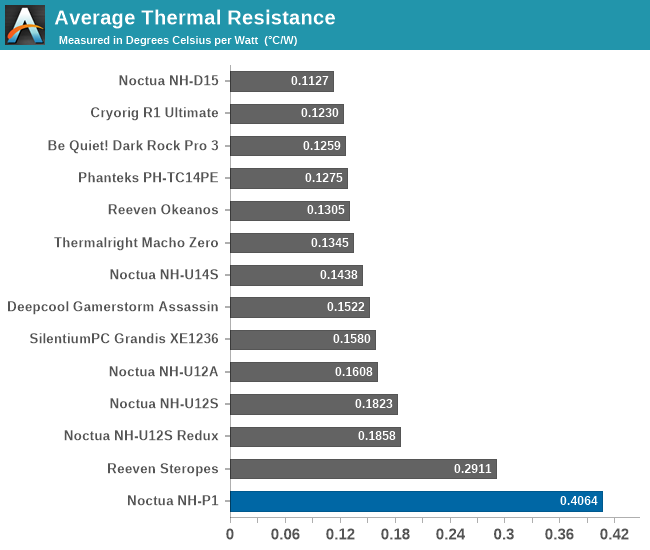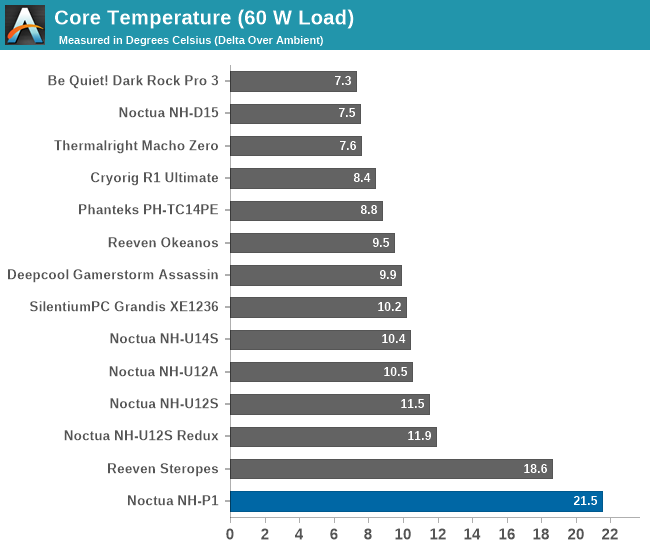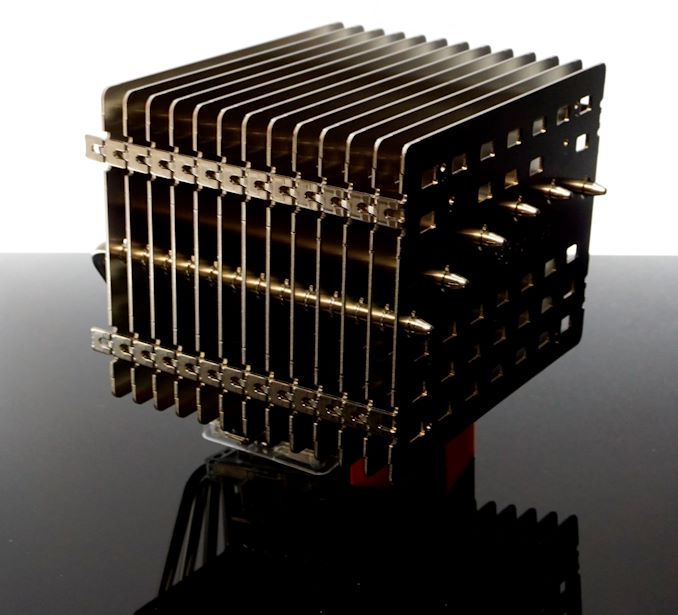The Noctua NH-P1 Passive CPU Cooler Review: Silent Giant
by E. Fylladitakis on February 7, 2022 8:00 AM EST- Posted in
- Cases/Cooling/PSUs
- Passive Cooling
- Noctua
- CPU cooler
Testing Results
As the Noctua NH-P1 does not have a fan at all, for fairness’ sake, we are comparing its performance with other coolers running at their low-noise mode (half fan speed). Still, due to the nature of the NH-P1 or, more precisely, its colossal mass, we tripled our regular testing time, allowing the temperature to stabilize.
Meanwhile, we are not publishing any noise-related tests for the obvious reasons: the NH-P1 does not generate the least bit of noise under any circumstances (at least, not while an optional fan is not attached to it). So all we could measure is the ambient noise, which is a function of our test environment rather than the cooler itself. (Though we were tempted to throw it into an anechoic chamber just to produce some truly crazy figures)
Finally, we should note that we are testing the NH-P1 in its purely passive form, without any forced airflow at or even near it.

As expected, the Noctua NH-P1 cannot compete directly against most typical CPU coolers that make use of forced convection. To that end, the NH-P1 displayed an average thermal resistance of 0.4064 °C/W, which is very high if compared against a top-tier CPU cooler, but does land in the same league as basic stock CPU cooler designs.

| Core Temperature, Constant Thermal Load |
|
|
The Noctua NH-P1 can handle loads lower than 100 Watts rather well. The temperatures will be high, but modern processors should happily operate at temperatures up to 50°C above ambient – assuming that the internal temperature of the PC case is relatively close to that of a typical household room (~22°C). Prolonged loads greater than 120-140 Watts will have the temperature delta widening too far for the NH-P1 to keep a chip from thermally throttling. The good news is that modern CPUs are designed to handle just such a thing (see: virtually any compact laptop in the last decade), but our testing equipment is another story: we had to stop our testing after 200W in order to avoid damaging our equipment.
We should point out again that these results require excessively prolonged testing time than normal, as the thermal inertia of the NH-P1 is outworldish. For typical PCs, where the CPU is not constantly running at full load, the thermal performance of the NH-P1 is bound to seem much better. Still, we would not recommend using it on infamously hot processors and/or on an overclocked processor. Think something closer to AMD & Intel's standard 65W parts, rather than their extreme K/X parts.
Final Words & Conclusion
Noctua is one of the most reputable PC cooling manufacturers for a reason: their products typically are well-designed and of excellent quality. The NH-P1 is no exception to that rule, and the timing of its release definitely is not coincidental. For example, with AIO coolers becoming increasingly popular over the past few years, typical PC cases nowadays are a bit wider and roomier, which allowed for the NH-P1 to greatly lengthen its compatibility table, as it would not fit the width of many older case designs.
Using a passive CPU cooler does have disadvantages, the most important being the (relatively) low thermal performance. The Noctua NH-P1 overcomes that issue, with the cooler offering passable thermal performance for most modern desktop PC processors. Its steady-state thermal resistance is comparable to that of a basic stock CPU cooler but its thermal inertia is colossal, meaning that it can maintain good operating temperatures under typical operational circumstances, as the processor will only be facing near-maximum loads for short periods of time. This massive thermal inertia comes from the respectively huge mass of the NH-P1, which limits the compatibility of the cooler and greatly increases its manufacturing cost.
With that said, the use of a passive CPU cooler also has other implications that need to be considered. The two major implications are significantly higher internal system temperatures and lack of airflow for improved VRM/motherboard cooling. Even in a well-designed passive system, the temperature of the motherboard’s critical components is almost certainly going to be significantly higher than a typical PC. Significant forced ventilation could remedy that, but the use of multiple case fans would defeat the purpose of a passive CPU cooler to begin with. Therefore, even if the CPU cooler itself could handle greater thermal loads, it would be problematic for the rest of the system to have such a huge dissipation of thermal energy inside it without any significant means of removing it.
It is also possible to add an optional 120 mm fan on the Noctua NH-P1. Most would think that using a fan defeats the purpose of having a passive CPU cooler in the first place but, on the other hand, most modern motherboards allow for the programming of meticulous cooling profiles. It would be very realistic to have a top-tier CPU and have the cooling fan operate only when, say, the temperature rises above 80 °C, even if as just a backup.
In terms of quality, Noctua never disappoints. If anything, their products usually are the benchmark for how top-tier designers and manufacturers should practice their business. The NH-P1 is very well-designed mechanically, excellently assembled, and is built from premium materials, all as we'd expect from a high-end Noctua product. But designing and building such a premium product is costly, and that is reflected by the $110 price tag of the NH-P1. The sheer mass of the NH-P1 ends up being a major factor here, as the costs of the nearly half a kilo of additional machined copper and aluminum needed to build such a large heatsink add up quickly.
Ultimately, it is clear that Noctua does not have the mainstream market in mind, but rather is going after advanced users who understand and accept the implications of using a passive cooler. In that respect the NH-P1 is very much a niche product, but it's also a product that fills that niche well. Building quiet PC systems has always been a popular design choice, and to that end Noctua's NH-P1 should find itself right at home in the silent PC community.











66 Comments
View All Comments
back2future - Wednesday, February 9, 2022 - link
might be a ~5-7yrs repeating task for 24/7 systems (and low rpm 120/140mm fans)?Since fans acoustics found being proportional to around 5th power of rpms, it might fit for some having 240/360mm fans for low rpm :) and airflow is what is needed for heat transfer: Having natural convection around an optimized passively cooled system might get to around 100W heat dissipation an given sizes for case and mainboard clearances and if there's no fan, a passive setup has to create its own 'air flow' speeds. Heat radiation is probably low percentage (with having shiny surfaces?) within device cases anyway? Some utilize ionic wind effects, etc.
TheinsanegamerN - Thursday, February 10, 2022 - link
Try 5-7 months. 5-7 years is a 1 way ticket to a system with a coating so heavy you can draw in it.back2future - Wednesday, February 9, 2022 - link
inspired for searching dust filter for fans, learned that items are available (with intake air flow reduction/resistance mostly not quantified, what might get a future review and compared to passive cooling systems?)shelbystripes - Wednesday, February 9, 2022 - link
Because a single fan to circulate air through the entire case is optimal for cooling everything inside the case. A heat sink with fan will move heat off the CPU … and around inside the case … still maintaining high ambient temperature inside the case, unless you have a second fan to move air through the case.Reducing to a single case can also allow use of a single LARGE case fan (something like 200mm, even) that runs at a low speed, and produces background noise that is less distracting. Smaller fans produce higher pitched buzzing sounds, and have to spin at high speeds to move substantial air; the inverse is also true.
jmke - Monday, February 7, 2022 - link
> Finally, we should note that we are testing the NH-P1 in its purely passive form, without any forced airflow at or even near it.while you did test the product in an isolated way, giving you excellent values. They are are however not relevant to real world usage. If you install this cooler in your case, near a <500rpm exhaust fan, your system will still be silent and the performance of this cooler will be much better than what your results show here.
imho an unfair evaluation of a product that's not tested as it will be used.
like testing 2 cars on a dragstrip, then saying that the Minivan is slower than the Porsche; never mind the fact that real world testing would have had 5 passengers.
at_clucks - Monday, February 7, 2022 - link
"near a <500rpm exhaust fan"A review for a passive cooler better focus on the worst case scenario: a passive build. Let's not assume someone paying premium for a high end passive cooler will mount other fans in there or place this under the AC.
You now have the baseline performance and you know putting a 500RPM exhaust fan will improve performance. You'll never worry that the performance is better than expected, you worry when it's worse.
WaltC - Thursday, February 10, 2022 - link
I have to agree here. Often a central element to a cooler review is how easy/hard is it to install, and of course how well it works (or doesn't work) when actually installed in a case. I feel like this would have been a royal pain in the derrière to install and test, of course, so I can sympathize with the author on that point. However, that raises the question of why try and review something you will not actually install and test in the environment which said product was designed for? That might be better than beginning a product review with a litany of the things you can't/won't be able to do...;) There are several low-power CPUs that might have been tested, imo, and that might function fine with this passive cooler. AT seems sometimes to shirk testing key elements of reviewed products--an advanced motherboard, for instance, with lots of hardware features was reviewed here. It was the kind of product a n00b would never buy because of its cost and complexity of features. Everything was fine until the review author said he wasn't going to look at the bios controls because, paraphrased, "hardly anyone messes with his bios these days." For that particular motherboard, nothing could be further from the fact of the matter...;) The people who would buy it have every intention of making adjustments according to their preferences in the bios. I would only suggest that AT editorial guidance be more insistence on completeness and thoroughness in the product reviews it publishes. Guesswork and estimations are all fine, but they are no substitute for real testing, imo.Dantte - Monday, February 7, 2022 - link
That beast is beautiful and is going to look great in my submerge build!Stuka87 - Monday, February 7, 2022 - link
I feel like the testing on this was a bit short sighted on the actual use case of this cooler. These testing done is still use full. But a good secondary test would be to have it in a situation where case air is going through it. Many cases use a front-to-back airflow setup. Are the fins oriented in a way to allow the air to go through the heat sink? And if so, how much better does it work?ington - Monday, February 7, 2022 - link
I'm a complete noob in cooling but the price of bunch of aluminium plates (however well they are machined) and copper rods seems steep... 1,5 times of raspberry pi 4b 8gb (an actual pc) as steep